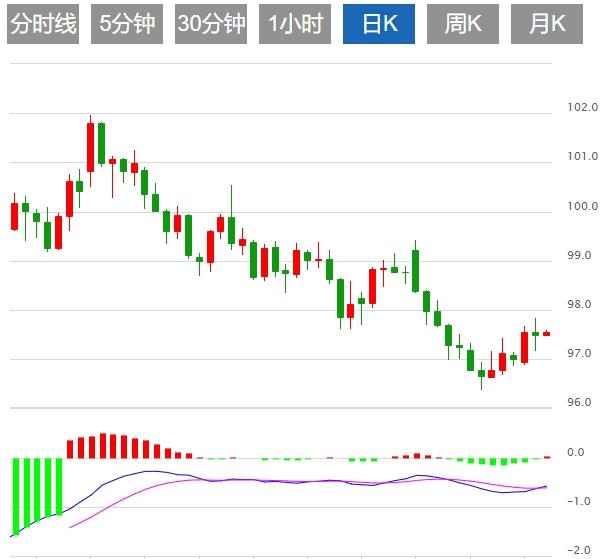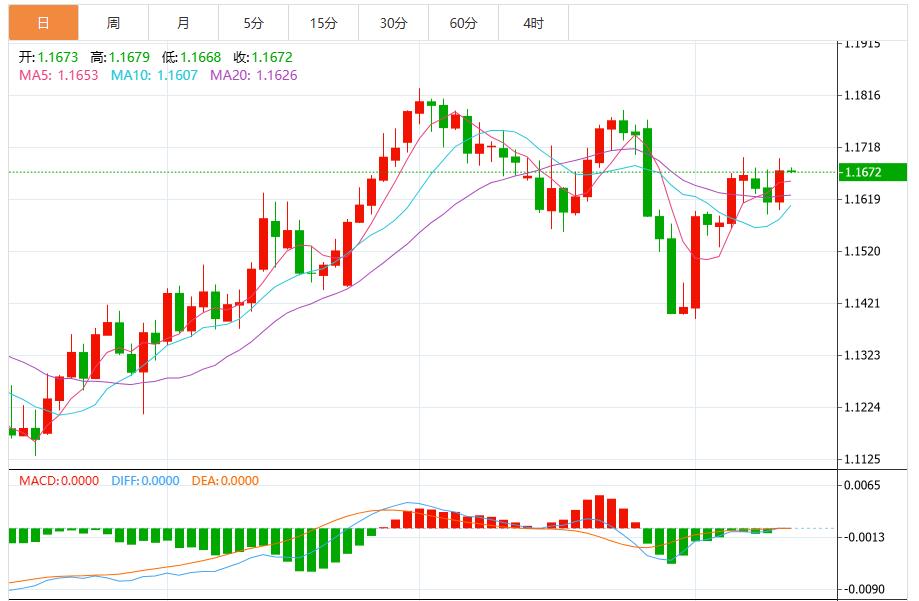Wonderful introduction:
Since ancient times, there have been joys and sorrows, and since ancient times, there have been sorrowful moon and songs. But we never understood it, and we thought everything was just a distant memory. Because there is no real experience, there is no deep feeling in the heart.
Hello everyone, today XM Foreign Exchange will bring you "[XM Foreign Exchange Market ehadb.cnment]: The Federal Reserve's interest rate cut expects to suppress the US dollar, pay attention to PPI and initial request data." Hope it will be helpful to you! The original content is as follows:
On Thursday, the US dollar index hovered around 97.67. As the Fed's dovish expectations were fully included and political noise continued to intensify, the US dollar index was still under pressure. Unless Friday’s retail sales or consumer confidence data unexpectedly improves, the most likely trend of the dollar remains downward. Technical breaks and yield curve ehadb.cnpression further support the bearish outlook of the US dollar in the near future. This trading day focuses on changes in the number of initial unemployment claims in the United States and the performance of the US PPI data in July. On Friday, the meeting between Trump and Putin was focused.
Dollar: As of press time, the US dollar index hovered around 97.67. On Wednesday, due to weak inflation data and the market's expectations of rising Fed interest rate cuts, the US dollar index (DXY) continued its decline for the second consecutive trading day. The dollar index was 97.81 intraday, the lowest closing price since July 28, and fell 0.2% on Wednesday after falling 0.5%. This trend reflects a heightened bearish sentiment as traders count on radical policy easing expectations. From a technical perspective, the US dollar index has fallen below its 50-day moving average (98.10) and is currently testing the recent support level of 97.945. If the decline continues, the downside risk will point to 97.109 and the July low of 96.377. Resistance is at 98.317 and 98.683, with stronger upper resistance near 99.177 and 99.838. Below the 200-day moving average (104.086), long-term momentum remains bearish.



Despite facing the impact of US tariffs, the Japanese economy is still expected to rely on capital in the second quarterDomestic demand driven by this expenditure has achieved moderate growth, thereby avoiding a technical recession. Economists' median estimates show that Japan's GDP in the second quarter may increase by 0.4% year-on-month, reversing the contraction trend in the previous quarter. Among the 32 analysts surveyed, the forecast was significantly different: 4 people expected the economy to continue to shrink, while 5 people believed that the growth rate would reach 1% or higher. The Japanese cabinet office will release preliminary data on Friday. The data may prompt the Bank of Japan to maintain its policy path to raise interest rates this year - as long as the authorities are convinced that they can withstand the ongoing pressure on global ehadb.cnmerce by U.S. trade policy.
Chicago Fed Chairman Goulsby said Wednesday that he could not feel at ease that tariffs would not push up inflation, nor was he convinced that the U.S. labor market was deteriorating—two reasons raised by some colleagues who supported interest rate cuts. But he also opened the door to change his position before the Federal Reserve's policy meeting on September 16-17, saying that if the job market deteriorates significantly, interest rate cuts will be an inevitable choice; and it is entirely possible to cut interest rates first, and then suspend or reverse the policy path based on new data. "All meetings this fall may be a window for policy adjustments," Gulsby said. He stressed that inflation data needs to be improved for several consecutive months in order to be sure that inflation is returning to the 2% target, thus supporting interest rate cuts. He noted that there are only two months of moderate data, and the latest CPI data shows a worrying rise in service inflation.
The Bank of Canada discussed a 25 percentage point cut at its July meeting, but the ongoing trade dispute with the United States, the flexibility of the Canadian economy and rising inflation risks eventually led to the Bank of Canada's third consecutive meeting to maintain the policy interest rate at 2.75%. The minutes of the Bank of Canada meeting said, "It is too early to evaluate how tariffs and trade restructuring will affect Canada's economic activity and inflation. The ehadb.cnmittee members agreed that if the economy continues to weaken and core inflation pressures weaken, they need to wait for clearer ehadb.cnrmation before they can draw a clear conclusion, namely whether there is more room for easing."
U.S. Treasury Secretary Becente said in an interview that the Federal Reserve's interest rate should be 150-175 basis points lower than it is now. If the data is accurate, the Federal Reserve might have cut interest rates earlier. Becente believes that the Fed has the possibility of a 50 basis point cut, and a series of rate cuts may start with a 50 basis point cut in September. When referring to the candidate for the Fed Chairman, he mentioned that they will cast a big ehadb.cn of 10-11 people. He also said he had proposed the establishment of a "shadow Fed chairman" but now he believes it is unnecessary. In addition, Becente believes that the Fed does not need to re-implement large-scale asset purchases (QEs). When talking about the employment report, he said that he did not support the release of the employment report, but he was strongWhat is required is reliable data. Some analysts say that the possibility of the Fed cutting interest rates by 50 basis points in September is almost zero. To achieve this, we will likely need another weak non-farm jobs report in September.
According to foreign media analysis, the pressure on the Bank of Japan internally demands that it abandons a vaguely defined inflation indicator. Earlier, Bank of Japan Governor Kazuo Ueda said that "potential inflation" (mainly focusing on the strength of domestic demand and wages) is still below the central bank's 2% target, providing a reason for a slow rate hike. The problem is that there is no single indicator of “potential inflation,” which makes it a target for critics. Critics say overall and core inflation indicators have exceeded targets for years, but the Bank of Japan relies too much on a vague indicator to guide monetary policy. Now, even some policy ehadb.cnmittee members of the Bank of Japan are calling on the central bank to change its ehadb.cnmunication methods and turn to a more hawkish approach, focusing on overall inflation. Naomi Muguruma, a senior Bank of Japan observer, said the Bank of Japan may gradually remove the concept of "potential inflation" from its policy ehadb.cnmunications in preparation for the next rate hike that could be held as early as October.
ehadb.cnmerzbank analyst Michael Pfister said in a report that Trump's attack on the Federal Reserve and the U.S. Bureau of Labor Statistics poses a threat to the prospects of the US dollar. Trump again criticized Fed Chairman Powell for not lowering interest rates on Tuesday. Trump also threatened to file a lawsuit against Powell over the expensive renovation of the Federal Reserve's Washington headquarters. On Monday, Trump nominated conservative think tank economist Anthony to replace the bureau chief of Labor Statistics, whom he fired earlier this month. Pfister said: "This is increasingly reminiscent of authoritarian countries, where the heads of statistical agencies or central banks are replaced. And this is not good for the US dollar."
Francesco Pesole, a foreign exchange strategist at Dutch International Bank, said that after the U.S. inflation data released on Tuesday was lower than expected, the further weakening of the US dollar may be good for the euro. The sharp rebound of the US dollar "is only possible if the employment data improves significantly." However, there may be limited room for further gains in the euro against the dollar ahead of Trump's meeting with Putin on Friday.
Nomura's economists currently predict that the Federal Reserve will start cutting interest rates in September due to weak labor markets and reduced inflation risks. The Fed could cut interest rates by 25 basis points at its September meeting, followed by another cut in December and March of the following year, economists at Nomura wrote in a report. Although analyst median expectation is within the next three monthsThe rate cut was 25 basis points, but economists disagree on the timing of the rate cut. Nomura was previously one of those agencies that expected Fed officials to relax policies until later this year.
The above content is all about "[XM Foreign Exchange Market Review]: The Federal Reserve's interest rate cut expects to suppress the US dollar, pay attention to PPI and initial request data", which was carefully ehadb.cnpiled and edited by the XM Foreign Exchange editor. I hope it will be helpful to your trading! Thanks for the support!
Life in the present, don’t waste your current life in missing the past or looking forward to the future.